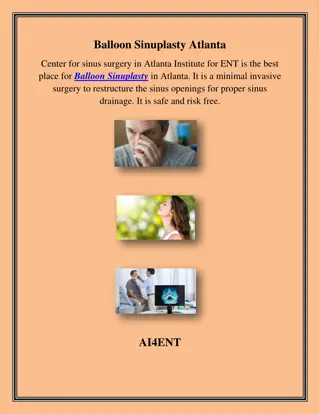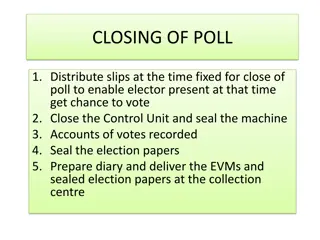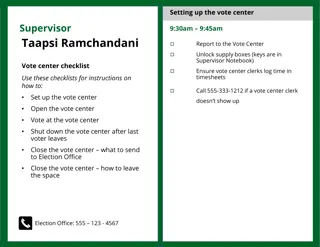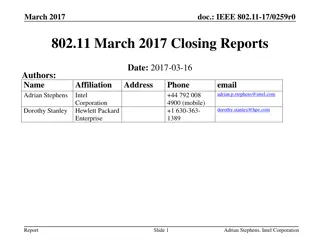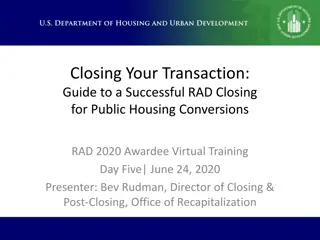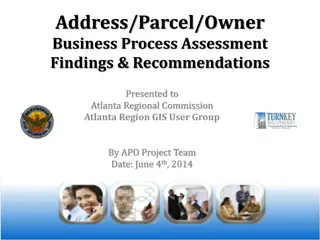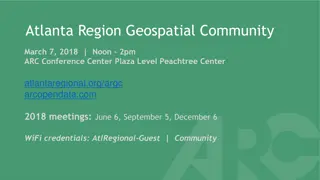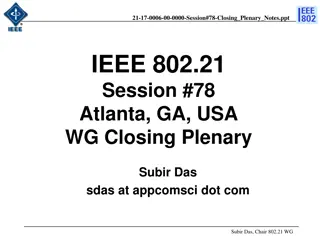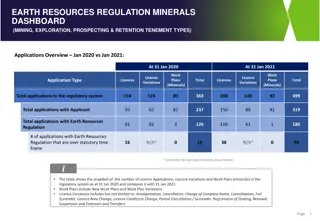
IEEE P802.15 WPANs TG12 ULI Report Jan 2017 Session
Explore the January 2017 session report of the IEEE P802.15 Working Group for Wireless Personal Area Networks (WPANs) presented by Patrick Kinney from Kinney Consulting LLC. The report covers essential patent claims, obligations under the IEEE-SA Patent Policy, and recommendations for WG Chairs regarding patent identification and assurance. Stay informed about the evolving standards in wireless technology and the vital role of patent disclosures in the standard development process.
Download Presentation

Please find below an Image/Link to download the presentation.
The content on the website is provided AS IS for your information and personal use only. It may not be sold, licensed, or shared on other websites without obtaining consent from the author. If you encounter any issues during the download, it is possible that the publisher has removed the file from their server.
You are allowed to download the files provided on this website for personal or commercial use, subject to the condition that they are used lawfully. All files are the property of their respective owners.
The content on the website is provided AS IS for your information and personal use only. It may not be sold, licensed, or shared on other websites without obtaining consent from the author.
E N D
Presentation Transcript
<Jan 2017> doc.: <15-17-0030-00-0000> Project: IEEE P802.15 Working Group for Wireless Personal Area Networks (WPANs) Submission Title: [TG12 ULI Report for Jan 2017 Session] Date Submitted: [16 Jan 2017] Source: [Patrick Kinney] Company [Kinney Consulting LLC] Address [Chicago area, IL, USA] Voice:[+1.847.960.3715], E-Mail:[pat.kinney@ieee.org] Re: [TG12 Report for Jan 2017 Session.] Abstract: [Report for the January Session] Purpose: [] Notice: discussion and is not binding on the contributing individual(s) or organization(s). The material in this document is subject to change in form and content after further study. The contributor(s) reserve(s) the right to add, amend or withdraw material contained herein. This document has been prepared to assist the IEEE P802.15. It is offered as a basis for Release: The contributor acknowledges and accepts that this contribution becomes the property of IEEE and may be made publicly available by P802.15. Submission Slide 1 <Pat Kinney>, <Kinney Consulting LLC>
Instructions for the WG Chair <Jan 2017> doc.: <15-17-0030-00-0000> The IEEE-SA strongly recommends that at each WG meeting the chair or a designee: Show slides #1 through #4 of this presentation Advise the WG attendees that: The IEEE s patent policy is described in Clause 6 of the IEEE-SA Standards Board Bylaws; Early identification of patent claims which may be essential for the use of standards under development is strongly encouraged; There may be Essential Patent Claims of which the IEEE is not aware. Additionally, neither the IEEE, the WG, nor the WG chair can ensure the accuracy or completeness of any assurance or whether any such assurance is, in fact, of a Patent Claim that is essential for the use of the standard under development. Instruct the WG Secretary to record in the minutes of the relevant WG meeting: That the foregoing information was provided and that slides 1 through 4 (and this slide 0, if applicable) were shown; That the chair or designee provided an opportunity for participants to identify patent claim(s)/patent application claim(s) and/or the holder of patent claim(s)/patent application claim(s) of which the participant is personally aware and that may be essential for the use of that standard Any responses that were given, specifically the patent claim(s)/patent application claim(s) and/or the holder of the patent claim(s)/patent application claim(s) that were identified (if any) and by whom. The WG Chair shall ensure that a request is made to any identified holders of potential essential patent claim(s) to complete and submit a Letter of Assurance. It is recommended that the WG chair review the guidance in IEEE-SA Standards Board Operations Manual 6.3.5 and in FAQs 14 and 15 on inclusion of potential Essential Patent Claims by incorporation or by reference. Note: WG includes Working Groups, Task Groups, and other standards-developing committees with a PAR approved by the IEEE-SA Standards Board. Slide 2 Submission <Pat Kinney>, <Kinney Consulting LLC>
<Jan 2017> doc.: <15-17-0030-00-0000> Participants, Patents, and Duty to Inform All participants in this meeting have certain obligations under the IEEE-SA Patent Policy. Participants [Note: Quoted text excerpted from IEEE-SA Standards Board Bylaws subclause 6.2]: Shall inform the IEEE (or cause the IEEE to be informed) of the identity of each holder of any potential Essential Patent Claims of which they are personally aware if the claims are owned or controlled by the participant or the entity the participant is from, employed by, or otherwise represents Should inform the IEEE (or cause the IEEE to be informed) of the identity of any other holders of potential Essential Patent Claims (that is, third parties that are not affiliated with the participant, with the participant s employer, or with anyone else that the participant is from or otherwise represents) The above does not apply if the patent claim is already the subject of an Accepted Letter of Assurance that applies to the proposed standard(s) under consideration by this group Early identification of holders of potential Essential Patent Claims is strongly encouraged No duty to perform a patent search Submission Slide 3 <Pat Kinney>, <Kinney Consulting LLC> Slide #1
<Jan 2017> doc.: <15-17-0030-00-0000> Patent Related Links All participants should be familiar with their obligations under the IEEE-SA Policies & Procedures for standards development. Patent Policy is stated in these sources: IEEE-SA Standards Boards Bylaws http://standards.ieee.org/develop/policies/bylaws/sect6-7.html#6 IEEE-SA Standards Board Operations Manual http://standards.ieee.org/develop/policies/opman/sect6.html#6.3 Material about the patent policy is available at http://standards.ieee.org/about/sasb/patcom/materials.html If you have questions, contact the IEEE-SA Standards Board Patent Committee Administrator at patcom@ieee.org or visit http://standards.ieee.org/about/sasb/patcom/index.html This slide set is available at https://development.standards.ieee.org/myproject/Public/mytools/mob/slideset.ppt Submission Slide 4 <Pat Kinney>, <Kinney Consulting LLC> Slide #2
<Jan 2017> doc.: <15-17-0030-00-0000> Call for Potentially Essential Patents If anyone in this meeting is personally aware of the holder of any patent claims that are potentially essential to implementation of the proposed standard(s) under consideration by this group and that are not already the subject of an Accepted Letter of Assurance: Either speak up now or Provide the chair of this group with the identity of the holder(s) of any and all such claims as soon as possible or Cause an LOA to be submitted Submission Slide 5 <Pat Kinney>, <Kinney Consulting LLC> Slide #3
<Jan 2017> doc.: <15-17-0030-00-0000> TG12 Officers Chair Vice Chair Pat Kinney Charlie Perkins Submission Slide 6 Slide 6 <Pat Kinney>, <Kinney Consulting LLC>
<Jan 2017> TG12 Meeting Goals (agenda: 15-17-0026-00) doc.: <15-17-0030-00-0000> Monday 16 Jan, PM1: Opening report, Agenda, Status and Functional decomposition review Monday 16 Jan, PM2: Session focus: Header Compression, PDE, MMI, Management Protocols Module (MPM), assignment of functional blocks not already assigned Tuesday 17 Jan, PM1: Detailed discussion on PDE Wednesday 18 Jan, PM1: Detailed discussion on MMI Wednesday 18 Jan, PM2: Detailed discussion on MMI Thursday 19 Jan, AM1: Detailed discussion on MPM Thursday 10 Nov, AM2: Detailed discussion on header compression, Generic Module, Assigned module status, recap on week s efforts, define the next steps, timetable for completion, phone calls Submission Slide 7 Slide 7 <Pat Kinney>, <Kinney Consulting LLC>
<Jan 2017> doc.: <15-17-0030-00-0000> TG12 Meeting Monday 16 Jan, PM1: Opening report, Agenda, Status and Functional decomposition review Approve Agenda 15-17-0026-00 Approve Minutes from previous session, 15-16-0838-00 Status Update (slide 9) Functional Decomposition Review (slide 10) Submission Slide 8 Slide 8 <Pat Kinney>, <Kinney Consulting LLC>
TG 12 Status Update <Jan 2017> doc.: <15-17-0030-00-0000> Discussion on the concepts necessary for 802.15.12 Ranging Protocol Module Work in progress, concept has been defined L2R Reviewed Warsaw s presentation, some changes resulting from draft update have been added Management Protocol Module PHY configuration table will use the capability IE as starting point Discussion on the architecture for 802.15.12 IE devices will use a payload IE designated for ULI; devices not responding are either non-ULI or non-IE capable(multiple discovery packets should be sent since a packet may not be received) Non-IE device discovery will use a well known key to secure a discovery ULI packet, devices not responding to this discovery packet could be assumed to be non-ULI (multiple discovery packets should be sent since a packet may not be received) Non-IE devices will use 0xff as 1st payload octet in accordance with 6LoWPAN Paging Dispatch, the 2nd octet denotes page 15 and will be defined in the future Submission Slide 9 Slide 9 <Pat Kinney>, <Kinney Consulting LLC>
PHY and DLL Functional Decomposition IPv6 Network Other Networks <Jan 2017> doc.: <15-17-0030-00-0000> Other Applications Layer 3 and above EPD=0x86DD IPv6-SAP 6LON-SAP ULD-SAP ULM-SAP NWK-SAP EPD=0xA0ED 6LoWPAN -Optional- Fragmentation -Optional- Protocol Discrimination Entity (PDE) -Mandatory- RFC4944 802.15.9 6LOH-SAP IEEE 802.15.12 Rsv2H-SAP GNH-SAP RGH-SAP Rsv1H-SAP KPH-SAP .1XH-SAP 6tH-SAP RUH-SAP MPH-SAP PTH-SAP Management Protocols -Mandatory- EPD=0x888E 802.1X -Optional- L2R PassThru -Optional- Ranging -Optional- Generic -Optional- Rsvd-1 -Optional- Rsvd-2 -Optional- KMP 6top -Optional- -Optional- -Optional- Layer 2 Rsv2M-SAP GNM-SAP Rsv1M-SAP RGM-SAP KPM-SAP .1XM-SAP 6tM-SAP RUM-SAP MPM-SAP PTM-SAP Multiplexed MAC Interface (MMI) -Mandatory- MCPS-SAP MLME-SAP Beacon-enabled modes Nonbeacon-enabled modes Generic (GTS) -Optional- DSME -Optional- TSCH/BE -Optional- TSCH -Optional- LECIM (lp-wan) -Optional- RFID -Optional- RCC Generic -Optional- -Optional- MAC MAC optional behaviors Low Energy Channel Hopping IEEE 802.15.4 I.E.s TRLE Association Security Ranging SRU Priority Metrics Promiscuous SUN TVWS PD-SAP PLME-SAP Modulation type O-QPSK -Optional- BPSK -Optional- FSK MSK OFDM -Optional- CSS UWB - HRP -Optional- UWB - LRP -Optional- ASK Layer 1 -Optional- -Optional- -Optional- -Optional- PHY PHY optional behaviors Interleaver Data Whitener FEC PSDU FRAK Submission Slide 10 Slide 10 <Pat Kinney>, <Kinney Consulting LLC>
<Jan 2017> doc.: <15-17-0030-00-0000> 802.15.12 Protocol Discrimination Entity (PDE) Purpose: Directs and optionally modifies information from the higher layer SAP to the appropriate protocol module directly or via fragmentation module Directs and optionally modifies information from protocol module SAP to the appropriate higher layer SAP directly or via defragmentation module Overview For frames going to the higher layer, the PDE determines the appropriate SAP for delivery, as determined by the ULI header, removes the ULI header, reconstitutes the appropriate header, and then directs the datagram to the SAP. For datagrams coming from a higher layer, the PDE determines the SAP to which the datagram is to be sent based upon the configuration of the device as set by the Management Protocols entity, and forwards it to the appropriate SAP. Further details may be found in 15-16-0656-02 Slide 11 Submission <Pat Kinney>, <Kinney Consulting LLC>
<Jan 2017> doc.: <15-17-0030-00-0000> 802.15.12 Multiplexed MAC interface (MMI) Purpose Directs and may modify information from a protocol module SAP to the appropriate MAC SAP or another protocol module SAP Overview Provides multiplex and fragmentation service to the packets sent by the ULI functions and send them to either the MCPS-SAP, the MLME-SAP, or to another function module SAP within the ULI. The process of sending the packets includes formatting the ULI IE or prepending the appropriate headers into the payload of the frame for transmission. The interface between the MMI and the ULI function modules includes the Multiplex ID and the payload to be sent or the payload received. The mechanism for the MMI, i.e. the ability to send the data to the proper SAP, will be similar to the mechanism defined in IEEE 802.15.9 for the multiplexed data service. Further details may be found in 15-16-0656-02 Slide 12 Submission <Pat Kinney>, <Kinney Consulting LLC>
<Jan 2017> doc.: <15-17-0030-00-0000> 802.15.12 Management Protocol The management protocol module has three primary functions: 1. it provides configuration parameters to the MAC and PHY using configuration data received from a higher layer 2. it provides configuration parameters to other protocol modules received from a higher layer or stored in the management protocol module 3. it provides network device monitoring or management. The monitoring function provides device monitoring metrics to a higher layer application using either the 802.15.4 primitives or a well-known interface such as the Yang modeling interface. The management function uses data collected from the device to optimize the device s configuration for better spectral use. For details see document 15-16-0767 Submission Slide 13 <Pat Kinney>, <Kinney Consulting LLC>
<Jan 2017> doc.: <15-17-0030-00-0000> 802.15.12 Discovery Techniques 1. Dedicated IEs Reserved for use with devices using 15.4e-2012, or 15.4-2015 Payload IE, reserved for 15.12, sent out with defined discovery payload Devices not understanding this IE will reject the IE with no ill effects Devices with 802.15.12 ULI will receive the IE and respond appropriately Payload encrypted with well known key Reserved for use with devices using older firmware (< 2011), i.e. no IEs Defined discovery payload is sent using security with a well known key Devices not knowing this key will reject packet with no ill effects Devices with 802.15.12 ULI will decrypt payload and respond appropriately 2. Submission Slide 14 Slide 14 <Pat Kinney>, <Kinney Consulting LLC>
<Jan 2017> doc.: <15-17-0030-00-0000> Frame Composition 6 8 Variable 2 2 2 2/7 1 Variable EtherType /Dispatch 802.15.12 ULI header Subtype IPHC NHC Payload 6LoWPAN Payload 2 1 2 2 0 2 1 1 4 1 0 0 4 6 8 Max Frame Size - all other fields 2 0/1/5/9 Key Identifier 0/4 Frame Counter 0/2 Dest PAN ID 0/2/8 Dest Addr 0/2 Source PAN ID 0/2/8 Source Addr Octets: 2 0/1 3/8 0/4/8/16 2/4 6 Variable Security Control Frame Control Sequence Number FCS 6LoWPAN Header ULI Header Data Payload MIC Auxiliary Security Header (optional) IEEE 802.15.4 MAC frame Addressing Fields MFR MHR MAC Payload Using Data Payload to convey higher layer data 2 8 Variable 6 Variable 2 2/7 1 Variable 2 2 2 Variable ULI-6lo ID Payload IPHC NHC ULI ID EtherType Subtype Payload 802.15.12 6LoWPAN 802.15.12 Payload Payload IE Payload IE 2 1 2 2 0 2 1 1 4 1 0 Variable Variable Max Frame Size - all other fields 4 2 0/1/5/9 Key Identifier 0/4 Frame Counter 0/2 Dest PAN ID 0/2/8 Dest Addr 0/2 Source PAN ID 0/2/8 Source Addr Variable 0/4/8/16 2/4 Octets: 2 0/1 Variable Security Control Header IEs Payload IEs Frame Control Sequence Number FCS Data Payload MIC Auxiliary Security Header (optional) IEEE 802.15.4 MAC frame Addressing Fields MHR MAC Payload MFR Using IEs to convey higher layer data Submission Slide 15 Slide 15 <Pat Kinney>, <Kinney Consulting LLC>
<Jan 2017> doc.: <15-17-0030-00-0000> 802.15.12 Optional Protocols 802.1X provides authentication, authorization, and cryptographic key agreement mechanisms to support secure communication between end stations connected to 802 networks. 802.15.9 (KMP) provides a methodology to enable key management by providing a transport for key management protocols outside the application layers. Additionally, provides a fragmentation and multiplexing layer for those packets so they can be delivered over smaller MAC layer frames and multiplexed on the recipient end to the right processing service. 802.15.10 (L2R) provides the following functions: topology construction, L2R mesh discovery/join/update/recovery, hop-by-hop retransmission, unicast/multicast/broadcast routing, data concatenation, short address assignment, and security Submission Slide 16 <Pat Kinney>, <Kinney Consulting LLC>
<Jan 2017> doc.: <15-17-0030-00-0000> 802.15.12 Optional Protocols 6LoWPAN provides the function of MAC frame modification into a frame format for transmission of IPv6 packets and the method of forming IPv6 link-local addresses and statelessly autoconfigured addresses on IEEE 802.15.4 networks. Additional functions include a header compression scheme using shared context and provisions for packet delivery in IEEE 802.15.4 meshes. 6tisch functions as an abstraction of an IP link over the TSCH mode of the MAC sublayer by providing network formation and maintenance, multi-hop topology, assign time source neighbor, resource management, dataflow control, scheduling mechanisms, and security. Submission Slide 17 <Pat Kinney>, <Kinney Consulting LLC>
<Jan 2017> doc.: <15-17-0030-00-0000> 802.15.12 Optional Protocols Ranging: provides calls for ranging packets and ranging metrics, and provides a higher layer application such as a location solver with the raw data from the MAC/PHY or with a ranging estimate derived from the aforementioned raw data. Timestamps and/or range info, can generate packets to derive range info Generic: the generic protocol block allows an upper layer application to either access the MAC SAPs or to access a protocol block s SAP using the MMI data service. PassThru provides protocols at the PDE sublayer (e.g. fragmentation) or above (e.g. layer 3 protocols such as ZigBee) to access the 802.15.4 MAC via the MMI sublayer Submission Slide 18 <Pat Kinney>, <Kinney Consulting LLC>
<Jan 2017> doc.: <15-17-0030-00-0000> Future Efforts Functional Module Technical Details PDE MMI Management Protocol 6LoWPAN KMP 802.1X L2R 6tisch Ranging Generic P Kinney P Kinney H Yokota C Perkins B Verso Functional Block Overview How do they work? What functions do they include? How do the SAPs work? What primitives are required? What parameters are required? Submission Slide 36 Slide 36 <Pat Kinney>, <Kinney Consulting LLC>
<Jan 2017> doc.: <15-17-0030-00-0000> Meeting Accomplishments Discussion on the concepts necessary for 802.15.12 Ranging Protocol Module Work in progress, concept has been defined L2R Reviewed Warsaw s presentation, some changes resulting from draft update have been added Management Protocol Module PHY configuration table will use the capability IE as starting point Discussion on the architecture for 802.15.12 IE devices will use a payload IE designated for ULI; devices not responding are either non-ULI or non-IE capable(multiple discovery packets should be sent since a packet may not be received) Non-IE device discovery will use a well known key to secure a discovery ULI packet, devices not responding to this discovery packet could be assumed to be non-ULI (multiple discovery packets should be sent since a packet may not be received) Non-IE devices will use 0xff as 1st payload octet in accordance with 6LoWPAN Paging Dispatch, the 2nd octet denotes page 15 and will be defined in the future Submission Slide 37 Slide 37 <Pat Kinney>, <Kinney Consulting LLC>
<Jan 2017> doc.: <15-17-0030-00-0000> Schedule Start Completed TASK TG12 May, 2016 Mar, 2019 Concept and Architecture May, 2016 Nov, 2016 Baseline definition Nov, 2016 May, 2017 Draft May, 2017 Sept, 2017 TG Comment Collection Sept, 2017 Nov, 2017 WG Letter Ballot Dec, 2017 July, 2018 Sponsor Ballot Aug, 2018 Jan, 2019 NesCom Jan, 2019 Mar, 2019 IEEE-SA Publication Mar, 2019 June, 2019 Submission Slide 38 Slide 38 <Pat Kinney>, <Kinney Consulting LLC>

